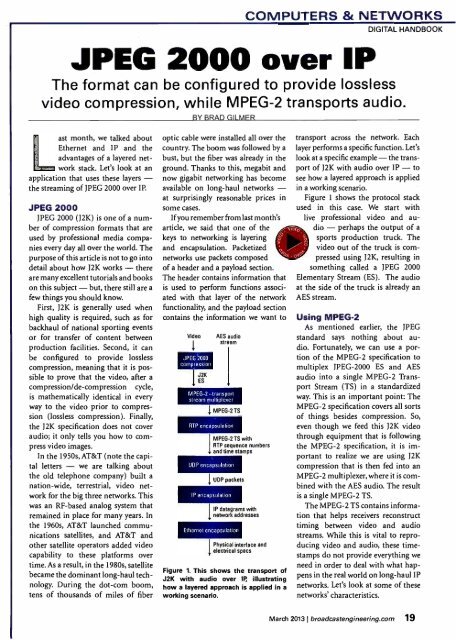ßroadcastEnsineerin - AmericanRadioHistory.Com
ßroadcastEnsineerin - AmericanRadioHistory.Com
ßroadcastEnsineerin - AmericanRadioHistory.Com
Create successful ePaper yourself
Turn your PDF publications into a flip-book with our unique Google optimized e-Paper software.
COMPUTERS & NETWORKS<br />
DIGITAL HANDBOOK<br />
JPEG 2000 over IP<br />
The format can be configured to provide lossless<br />
video compression, while MPEG -2 transports audio.<br />
BY BRAD GILMER<br />
Last month, we talked about<br />
Ethernet and IP and the<br />
advantages of a layered network<br />
stack. Let's look at an<br />
application that uses these layers -<br />
the streaming of JPEG 2000 over IP.<br />
JPEG 2000<br />
JPEG 2000 (J2K) is one of a number<br />
of compression formats that are<br />
used by professional media companies<br />
every day all over the world. The<br />
purpose of this article is not to go into<br />
detail about how J2K works - there<br />
are many excellent tutorials and books<br />
on this subject - but, there still are a<br />
few things you should know.<br />
First, J2K is generally used when<br />
high quality is required, such as for<br />
backhaul of national sporting events<br />
or for transfer of content between<br />
production facilities. Second, it can<br />
be configured to provide lossless<br />
compression, meaning that it is pos-<br />
sible to prove that the video, after a<br />
compression /de- compression cycle,<br />
is mathematically identical in every<br />
way to the video prior to compression<br />
(lossless compression). Finally,<br />
the 12K specification does not cover<br />
audio; it only tells you how to compress<br />
video images.<br />
In the 1950s, AT &T (note the capital<br />
letters - we are talking about<br />
the old telephone company) built a<br />
nation -wide, terrestrial, video network<br />
for the big three networks. This<br />
was an RF -based analog system that<br />
remained in place for many years. In<br />
the 1960s, AT &T launched communications<br />
satellites, and AT &T and<br />
other satellite operators added video<br />
capability to these platforms over<br />
time. As a result, in the 1980s, satellite<br />
became the dominant long -haul technology.<br />
During the dot -corn boom,<br />
tens of thousands of miles of fiber<br />
optic cable were installed all over the<br />
country. The boom was followed by a<br />
bust, but the fiber was already in the<br />
ground. Thanks to this, megabit and<br />
now gigabit networking has become<br />
available on long -haul networks -<br />
at surprisingly reasonable prices in<br />
some cases.<br />
If you remember from last month's<br />
article, we said that one of the<br />
keys to networking is layering<br />
and encapsulation. Packetized<br />
networks use packets composed<br />
of a header and a payload section.<br />
The header contains information that<br />
is used to perform functions associated<br />
with that layer of the network<br />
functionality, and the payload section<br />
contains the information we want to<br />
Video<br />
AES audio<br />
stream<br />
i<br />
MPEG -2 - transport<br />
stream multiplexer<br />
1 MPEG-2 TS<br />
RTP encapsulation<br />
UDP encapsulation<br />
MPEG -2 TS with<br />
RTP sequence numbers<br />
and time stamps<br />
UDP packets<br />
1<br />
IP encapsulation<br />
IP datagrams with<br />
network addresses<br />
Ethernet encapsulation<br />
Physical interface and<br />
electrical specs<br />
Figure 1. This shows the transport of<br />
J2K with audio over IP, illustrating<br />
how a layered approach is applied in a<br />
working scenario.<br />
transport across the network. Each<br />
layer performs a specific function. Let's<br />
look at a specific example - the transport<br />
of J2K with audio over IP - to<br />
see how a layered approach is applied<br />
in a working scenario.<br />
Figure 1 shows the protocol stack<br />
used in this case. We start with<br />
live professional video and audio<br />
- perhaps the output of a<br />
sports production truck. The<br />
video out of the truck is compressed<br />
using J2K, resulting in<br />
something called a JPEG 2000<br />
Elementary Stream (ES). The audio<br />
at the side of the truck is already an<br />
AES stream.<br />
Using MPEG -2<br />
As mentioned earlier, the JPEG<br />
standard says nothing about audio.<br />
Fortunately, we can use a portion<br />
of the MPEG -2 specification to<br />
multiplex JPEG -2000 ES and AES<br />
audio into a single MPEG -2 Transport<br />
Stream (TS) in a standardized<br />
way. This is an important point: The<br />
MPEG -2 specification covers all sorts<br />
of things besides compression. So,<br />
even though we feed this J2K video<br />
through equipment that is following<br />
the MPEG -2 specification, it is important<br />
to realize we are using J2K<br />
compression that is then fed into an<br />
MPEG -2 multiplexer, where it is combined<br />
with the AES audio. The result<br />
is a single MPEG -2 TS.<br />
The MPEG -2 TS contains information<br />
that helps receivers reconstruct<br />
timing between video and audio<br />
streams. While this is vital to reproducing<br />
video and audio, these time -<br />
stamps do not provide everything we<br />
need in order to deal with what happens<br />
in the real world on long -haul IP<br />
networks. Let's look at some of these<br />
networks' characteristics.<br />
March 2013 I broadcastengineering.com 19
















